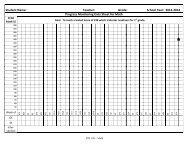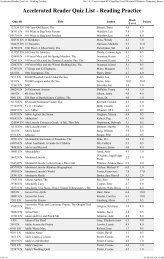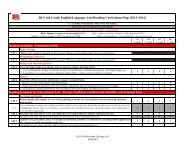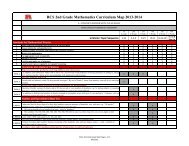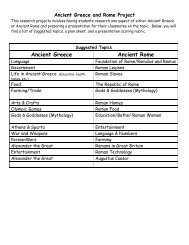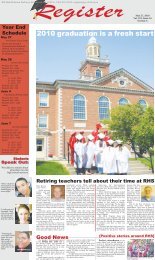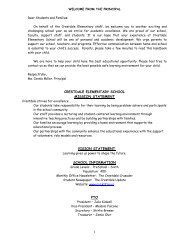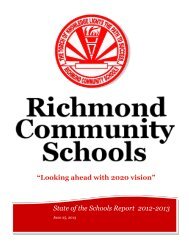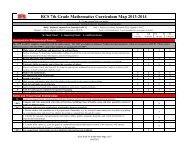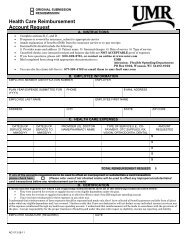Ubd Unit Indian Boarding Schools.pdf - Richmond Community Schools
Ubd Unit Indian Boarding Schools.pdf - Richmond Community Schools
Ubd Unit Indian Boarding Schools.pdf - Richmond Community Schools
Create successful ePaper yourself
Turn your PDF publications into a flip-book with our unique Google optimized e-Paper software.
Name: Kelly Amos<br />
Title: Between Two Worlds: The <strong>Indian</strong> <strong>Boarding</strong> School Experience<br />
Grade Level: 4 th grade (adaptable for many grades)<br />
SUMMARY OF THE UNIT<br />
This unit will explore concept of cultural diversity in the classroom and beyond. As students<br />
learn about the injustices faced by Native American children in the implementation of the<br />
boarding school system, they can come to more fully appreciate the multiculturalism they<br />
experience each day. Through historical fiction picture books, autobiographical accounts, and<br />
primary source photos children will gain an understanding of forced assimilation and its<br />
consequences.<br />
SUGGESTED RESOURCES<br />
<br />
<br />
<br />
<br />
<br />
The Ledger book of Thomas Blue Eagle by Jewel Grutman, Gay Matthaei, Thomasson<br />
Grant<br />
Cheyenne Again by Eve Bunting<br />
Home to Medicine Mountain by Chiori Santiago<br />
http://www.loc.gov/teachers/classroommaterials/primarysourcesets/assimilation/<br />
http://www.english.illinois.edu/maps/poets/a_f/erdrich/boarding/gallery.htm<br />
See Teacher Resources on TAH page for additional links and <strong>pdf</strong> files<br />
MATERIALS NEEDED<br />
<br />
<br />
<br />
<br />
Classroom meeting area where all students can see as you read-aloud to them and where<br />
they can pair-share their thoughts, feelings, wonderings about book or topic<br />
Smartboard or LCD projector with which to project images primary source photographs<br />
of boarding school students<br />
Easel or chart paper to record student ideas<br />
Student diaries used in performance task (1 per student)<br />
1
Competencies/Standards<br />
STAGE 1 – Identify desired results<br />
NCSS Curriculum Standards<br />
I. Culture<br />
Social studies programs should include experiences that provide for the study of culture and cultural<br />
diversity, so that the learner can:<br />
a. explore and describe similarities and differences in the ways groups, societies, and cultures address<br />
similar human needs and concerns<br />
b. give examples of how experiences may be interpreted differently by people from diverse cultural<br />
perspectives and frames of reference<br />
d. compare ways in which people from different cultures think about and deal with their physical<br />
environment and social condition<br />
e. give examples and describe the importance of cultural unity and diversity within and across groups<br />
CCSS.ELA-Literacy.RI.4.3 Explain events, procedures, ideas, or concepts in a historical, scientific, or<br />
technical text, including what happened and why, based on specific information in the text<br />
CCSS.ELA-Literacy.W.4.3 Write narratives to develop real or imagined experiences or events using<br />
effective technique, descriptive details, and clear event sequences<br />
o CCSS.ELA-Literacy.W.4.3a Orient the reader by establishing a situation and introducing a<br />
narrator and/or characters; organize an event sequence that unfolds naturally.<br />
o CCSS.ELA-Literacy.W.4.3b Use dialogue and description to develop experiences and events or<br />
show the responses of characters to situations.<br />
o CCSS.ELA-Literacy.W.4.3c Use a variety of transitional words and phrases to manage the<br />
sequence of events.<br />
o CCSS.ELA-Literacy.W.4.3d Use concrete words and phrases and sensory details to convey<br />
experiences and events precisely.<br />
o CCSS.ELA-Literacy.W.4.3e Provide a conclusion that follows from the narrated experiences or<br />
events.<br />
CCSS.ELA-Literacy.W.4.1 Write opinion pieces on topics or texts, supporting a point of view with<br />
reasons and information.<br />
CCSS.ELA-Literacy.W.4.4 Produce clear and coherent writing in which the development and organization<br />
are appropriate to task, purpose, and audience<br />
CCSS.ELA-Literacy.L.4.5a Explain the meaning of simple similes and metaphors (e.g., as pretty as a<br />
picture) in context<br />
CCSS.ELA-_Literacy 4.W.8 Recall relevant information from experiences or gather relevant information<br />
from print and digital sources; take notes and categorize information, and provide a list of sources.<br />
NAEP Theme 2- The gathering and interactions of peoples, cultures, and ideas<br />
NAEP Writing Purposes: To explain, in order to expand the reader’s understanding<br />
To convey experience (real or imagined), in order to communicate individual and<br />
imagined experiences to others<br />
2
Enduring Understandings (“Students will understand THAT…”)<br />
Overarching Enduring Understandings<br />
People of all cultures can have a positive influence on the world and deserve our respect.<br />
Topical Enduring Understandings<br />
Through the <strong>Indian</strong> boarding school system, children were pressured, and even forced to<br />
abandon their native traditions and identities.<br />
The boarding school experience negatively and sometimes positively impacted Native<br />
students’ lives.<br />
Essential Questions (“How…” “Why…” “To what extent…”)<br />
Overarching Essential Questions<br />
How can we support diversity in our school?<br />
Is it difficult to integrate into a culture that is different from your own?<br />
Topical Essential Questions<br />
Why did the <strong>Indian</strong> boarding school model fail?<br />
To what extent can someone’s cultural identity be taken from them?<br />
Were the boarding schools an attempt to erase the Native American culture?<br />
Enabling Knowledge and Skills (“What skills and conceptual knowledge must<br />
students possess in order to demonstrate understanding – especially on performance<br />
tasks?”)<br />
Students will know<br />
Students will be able to<br />
1. Diversity is a positive contribution to their classroom, 1. Create a fictional diary of a child in a<br />
their school, and their larger community<br />
boarding school with supportive evidence from<br />
2. Off-reservation boarding schools were an effort for the text read in class.<br />
government to solve the “<strong>Indian</strong> problem”.<br />
2. Organize the diary in the correct sequence<br />
3. Many Native American children were affected by their and with the development of the inner voice of<br />
experiences at boarding schools.<br />
main fictional character.<br />
4. Integrating into a culture whose main population is 3. Use transitional words and varied word<br />
different from your own can be a difficult experience.<br />
choice in writing.<br />
4. Write a short opinion piece in response to<br />
topical question.<br />
5. Write quick-responses to literature.<br />
6. Analyze primary resource photos.<br />
7. Identify a simile in an author’s text and use a<br />
simile in their own writing<br />
3
Overview of assessment evidence<br />
STAGE 2 – Determine acceptable evidence<br />
Briefly describe the types of assessment activities you will use throughout this unit to ensure students are gaining the<br />
enabling conceptual knowledge and skills they need so that ultimately they can demonstrate understanding through<br />
the major performance task.<br />
TYPE OF<br />
EVIDENCE<br />
Primary<br />
performance<br />
task<br />
DESCRIPTION OF THE ASSESSMENT<br />
ACTIVITY<br />
Students will create a fictional diary from the<br />
view point of a Native American child in a<br />
boarding school<br />
(NAEP Theme 2- The gathering and interactions of<br />
peoples, cultures, and ideas, NAEP Writing Purpose-to<br />
convey an imagined experience)<br />
Similarities and differences between our<br />
school and boarding school experience<br />
WHICH<br />
FACET OF<br />
UNDERSTANDING IS<br />
EMPHASIZED?<br />
Perspective; Interpretation<br />
Self-Knowledge<br />
Written prompts/<br />
journals<br />
Do all students feel accepted and respected by<br />
one another despite differences in tradition,<br />
language, and culture that may be present?-<br />
Write, Pair, Share<br />
Small<br />
projects/skill<br />
demonstrations/<br />
supporting<br />
performances<br />
What does civilized look like?- Write, Pair,<br />
Share<br />
-short opinion piece of writing about why<br />
diversity is important in the classroom and<br />
how we can support everyone’s differences in<br />
the classroom and beyond<br />
-quick writes in response to read-alouds<br />
-Venn Diagram comparing and contrasting<br />
author’s experiences in boarding schools<br />
Application<br />
Empathize<br />
Explain<br />
Student selfassessments<br />
rubric for diary for student use before turning<br />
in their performance task<br />
exit tickets<br />
Self-Knowledge<br />
4
Observing<br />
/conferencing<br />
Observe students during group work<br />
Explain<br />
GRASPS details for the primary performance task<br />
Use the GRASP format to provide more detailed information about the primary performance task through which you<br />
will assess students’ growing understanding.<br />
5<br />
GRASPS<br />
Goal<br />
Provide a statement of<br />
the task.<br />
Establish the goal,<br />
problem, challenge, or<br />
obstacle in the task.<br />
Role<br />
Define the role of the<br />
students in the task.<br />
State the job of the<br />
students for the task.<br />
Audience<br />
Identify the target<br />
audience within the<br />
context of the<br />
scenario.<br />
Example audiences<br />
might include a client<br />
or a committee.<br />
Situation<br />
Set the context of the<br />
scenario.<br />
Explain the situation.<br />
Product<br />
Clarify what the<br />
students will create<br />
and why they will<br />
create it.<br />
Standards and Criteria<br />
Provide students with<br />
a clear picture of<br />
success.<br />
Identify specific<br />
Use of GRASPS in this <strong>Unit</strong><br />
Your task is to create a fictional diary seen through the eyes of a Native<br />
American boy or girl in which you write about your daily life at a<br />
boarding school.<br />
You are a Native American boy or girl living at a Residential <strong>Boarding</strong><br />
School in the late 1800s.<br />
No audience- For yours eyes only! (would not want any teachers to<br />
find your diary for fear of consequences)<br />
As you left your tribal home, your older brother told you to keep a<br />
diary while at school if you become lonely. But he warned you to keep<br />
it hidden from Teacher!<br />
You are to create a 10 entry diary account of your daily life as a Native<br />
American boy or girl at an off-reservation boarding school during the<br />
late 1800s. Draw upon the texts read in class and the primary source<br />
information viewed to give your diary authenticity. Think about what<br />
“your” life would be like at a boarding school. What thoughts would<br />
you want to write down in a diary? What new, different, or difficult<br />
experiences could you share in a diary because you do not have your<br />
family there to share it with?<br />
See rubric in Teacher Resources on TAH page
standards for success.<br />
Issue rubrics to the<br />
students.<br />
STAGE 3 – Design learning activities<br />
Use the WHERETO model to identify the type – but not the sequence – of instructional activities required to<br />
promote the desired results. Following the WHERETO model is an optional calendar for actually scheduling the<br />
sequence of learning activities. Note that assessment activities (the second “E” and to some extent the “R” in<br />
WHERETO) are embedded throughout the unit.<br />
WHERETO<br />
W<br />
H<br />
E<br />
R<br />
E<br />
T<br />
O<br />
How will you ensure that all<br />
students know where they are<br />
headed in the unit, why they are<br />
headed there, and how they will be<br />
evaluated?<br />
How will you hook students at the<br />
beginning of the unit?<br />
What events will help students<br />
experience and explore the big ideas<br />
and questions in the unit? How will<br />
you equip them with needed skills<br />
and knowledge?<br />
How will you cause students to<br />
reflect and rethink? How will you<br />
guide them in rehearsing, revising,<br />
and refining their work?<br />
How will you help students to<br />
exhibit and self-evaluate their<br />
growing skills, knowledge, and<br />
understanding throughout the unit?<br />
How will you tailor instruction to<br />
meet student need in readiness,<br />
learning style, and interest while<br />
remaining true to the desired result?<br />
How will you organize learning experiences<br />
to maximize engagement and understanding<br />
and minimize misconceptions?<br />
“W” Ideas<br />
Introduce the essential questions and discuss their thinking as it<br />
stands at the beginning of the unit. Discuss culminating<br />
performance task.<br />
“H” Ideas<br />
Begin by showing a photograph of your class to your class. What<br />
differences/similarities do they see?<br />
“E1” Ideas<br />
Exploring quality children’s literature on the topic of Native<br />
American <strong>Boarding</strong> <strong>Schools</strong><br />
Examining and analyzing students’ of their time at a boarding<br />
school<br />
Create a fictional diary account of a child at a<br />
boarding school<br />
“R” Ideas<br />
Write, pair, shares<br />
Anecdotal notes in group discussion<br />
“E2” Ideas<br />
Exit-tickets<br />
Rubric for performance task<br />
“T” Ideas<br />
Most text is accessible as it is read aloud to the students. Other text<br />
will be done with partner support. The performance task is open for an<br />
addition of artwork with the diary entries (ledger art would be<br />
particularly interesting). Poetry form could take the place of diary<br />
entries<br />
“O” Ideas<br />
Continually refer to essential questions and new understandings<br />
throughout unit as their understanding deepens<br />
Students reflect on the ways in which they can support diversity in their<br />
school<br />
6
Sequence of unit learning and assessment activities<br />
Calendar<br />
Monday Tuesday Wednesday Thursday Friday<br />
Introduce the essential<br />
questions and discuss their<br />
thinking as it stands at the<br />
beginning of the unit. Discuss<br />
culminating performance task.<br />
Use Hook as mentioned above<br />
Learn about what diversity<br />
mean.<br />
Work in small group to<br />
brainstorm differences in a<br />
small group.<br />
Journal response to<br />
How is my classroom better<br />
because everyone is not the<br />
same?<br />
Early Dismissal Cheyenne Again Day 2 with<br />
student written response<br />
Cheyenne Again Day 2<br />
with student written<br />
responses<br />
What does it mean to be<br />
civilized? How are civilized<br />
persons different from<br />
uncivilized persons?<br />
Who decides who is civilized<br />
and who is not?<br />
Discuss what primary source<br />
photo is. Give a few examples<br />
using before and after photo<br />
from <strong>Indian</strong> <strong>Boarding</strong> school<br />
website a discuss perspective of<br />
what “civilized” means.<br />
Exit Ticket for the Week<br />
Take students to the computer<br />
lab to view the primary<br />
resources on the Library of<br />
Congress Assimilation through<br />
Education website. Students<br />
will be analyzing this<br />
resources for new information<br />
learned about life at boarding<br />
schools<br />
Early dismissal<br />
Read Home to Medicine<br />
Mountain and complete<br />
activities<br />
The Home to Medicine<br />
Mountain Day 2 with<br />
student written response<br />
Take students back to the<br />
computer lab to view the<br />
website <strong>Indian</strong> <strong>Boarding</strong><br />
School. Ask students to choose<br />
a before and after photograph to<br />
compare and contrast.<br />
Exit Ticket for the Week<br />
“Do all students feel accepted<br />
and respected by one another<br />
despite differences in tradition,<br />
language, and culture that may<br />
be present?”<br />
Class discussion with charted<br />
responses. Students write<br />
opinions with support.<br />
Early dismissal<br />
Read The Ledger book of<br />
Thomas Blue Eagle and<br />
complete activities<br />
The Ledger book of<br />
Thomas Blue Eagle Day 2<br />
with student written<br />
response<br />
Watch YouTube video on<br />
Teacher Resources page<br />
Introduce performance task to<br />
students<br />
Exit Ticket for the Week<br />
Students work on fictional<br />
diaries for the week. Have<br />
access to all the week’s texts<br />
as source materials for their<br />
writing.<br />
Early dismissal<br />
Students work on fictional<br />
diaries for the week. Have<br />
access to all the week’s<br />
texts as source materials for<br />
their writing.<br />
Students work on fictional<br />
diaries for the week. Have<br />
access to all the week’s<br />
texts as source materials<br />
for their writing. Students<br />
should be using the rubric<br />
to check over their diaries.<br />
Students should be completing<br />
their diaries with their selfassessment<br />
rubrics.<br />
7
Lesson # 1<br />
Title: Introduction<br />
Duration: 1-2 days<br />
Learning Goals Based on Standards:<br />
Social studies programs should include experiences that provide for the study of culture and cultural diversity, so that the learner can:<br />
a. explore and describe similarities and differences in the ways groups, societies, and cultures address similar human needs and concerns<br />
b. give examples of how experiences may be interpreted differently by people from diverse cultural perspectives and frames of reference<br />
d. compare ways in which people from different cultures think about and deal with their physical environment and social condition<br />
e. give examples and describe the importance of cultural unity and diversity within and across groups<br />
Essential Questions:<br />
How can we support diversity in our school?<br />
Is it difficult to integrate into a culture that is different from your own?<br />
Students will Know:<br />
1. what topic will be<br />
covered in unit<br />
2. the essential<br />
questions for the unit<br />
3. expectations for<br />
performance task<br />
Students will Understand:<br />
1. what diversity<br />
means<br />
2. diversity in the<br />
classroom<br />
Students will Do:<br />
1. individual written response<br />
2. small group written work<br />
Assessment: How will students demonstrate the desired understandings? (Performance tasks, quizzes, tests,<br />
journals, homework, observations, etc.) How will understanding be judged?<br />
1. journal<br />
2. observation as students work in groups<br />
3. group exploration sheet (readwritethink.org)<br />
Instructional Activities/Sequence:<br />
Begin by showing a photograph of your class to your class. What differences/similarities do they see?<br />
Further the topic of diversity by drawing students' attentions to more differences and similarities. You can<br />
present four or five criteria statements for the class to consider and ask students to stand up in groups. Some<br />
examples of criteria statements are:<br />
-All the boys stand up<br />
-Everyone wearing pink stand up<br />
-If you speak a second language<br />
-Stand up if you have ever lived in a different state<br />
Why is it important to share these differences? What can they help us understand about each other?<br />
Write the word diversity on the board and ask students if they know what it means. Jot down their responses<br />
working toward the following definition: Being different from each other.<br />
Create a classroom T-chart of the similarities and differences that the students have with one another.<br />
Place students into small groups and pass out the Group Exploration Sheet. Explain that they will talk about<br />
how they and their classmates are different than each other and other people in the world. Each group should<br />
use the Exploration Sheet to make lists of differences that are not already included on the classroom T-chart.<br />
Each student should take turns writing ideas on the list; every student in the group should write down at least<br />
one idea. Tell students that they all need to make sure that their group members are sharing positive ideas<br />
that will not hurt anyone's feelings.<br />
Bring students back together for a class discussion. Ask them what kinds of differences they discovered in<br />
8
their groups. What was the most surprising difference to them? What did they learn from their group<br />
discussion?<br />
Tell students that in this unit they are going to learning about a time period during which the government<br />
forced many Native American children to attend schools away from their parents and away from the life that<br />
they knew. Students had to give up how they spoke, how they dressed, what they believed, in order to fit in<br />
with European standards. These schools did not celebrate these students’ diversity. Introduce essential<br />
questions for unit.<br />
Ask students to respond to the following questions<br />
How is my classroom better because everyone is not the same?<br />
Share with table partners, then share whole groups.<br />
(partially adapted from Readworks.org)<br />
Resources:<br />
Group Exploration Sheet<br />
9
Lesson # 2<br />
Title: Cheyenne Again<br />
Duration: 2 days<br />
Learning Goals Based on Standards:<br />
NCSS Curriculum Standards<br />
II. Culture<br />
Social studies programs should include experiences that provide for the study of culture and cultural diversity, so that the learner can:<br />
c. explore and describe similarities and differences in the ways groups, societies, and cultures address similar human needs and concerns<br />
d. give examples of how experiences may be interpreted differently by people from diverse cultural perspectives and frames of reference<br />
d. compare ways in which people from different cultures think about and deal with their physical environment and social condition<br />
e. give examples and describe the importance of cultural unity and diversity within and across groups<br />
CCSS.ELA-Literacy.RI.4.3 Explain events, procedures, ideas, or concepts in a historical, scientific, or technical text, including what happened<br />
and why, based on specific information in the text<br />
CCSS.ELA-Literacy.W.4.4 Produce clear and coherent writing in which the development and organization<br />
are appropriate to task, purpose, and audience<br />
CCSS.ELA-Literacy.W.4.3 Write narratives to develop real or imagined experiences or events using effective technique, descriptive details, and<br />
clear event sequences<br />
Essential Questions:<br />
How can we support diversity in our school?<br />
Is it difficult to integrate into a culture that is different from your own?<br />
(Topical Questions)<br />
Why did the <strong>Indian</strong> boarding school model fail?<br />
To what extent can someone’s cultural identity be taken from them?<br />
Were the boarding schools an attempt to erase the Native American culture?<br />
Students will Know:<br />
1. the government used<br />
boarding schools to<br />
try and assimilate<br />
Native Americans<br />
into American<br />
culture<br />
2. what circumstances<br />
were like at some<br />
<strong>Indian</strong> boarding<br />
schools (as<br />
described in book)<br />
3. how writers make<br />
creative choices<br />
about how to end<br />
their text that reader<br />
may disagree with<br />
Students will Understand:<br />
1. students who<br />
attended boarding<br />
schools were<br />
affected by their<br />
time in many ways<br />
2. characters have both<br />
an outside<br />
appearance and an<br />
inner voice<br />
Students will Do:<br />
1. journal response<br />
2. story writing<br />
3. open-minded portrait<br />
Assessment: How will students demonstrate the desired understandings? (Performance tasks, quizzes, tests,<br />
journals, homework, observations, etc.) How will understanding be judged?<br />
1. student journal responses<br />
2. written responses to text<br />
3. open-minded portraits<br />
4. observation of discussion<br />
10
Instructional Activities/Sequence:<br />
Ask students to respond in their journals to the following :<br />
Do all students feel accepted and respected by one another despite differences in tradition, language,<br />
and culture that may be present? Pair and Share their responses<br />
Explain that you are going to read them a book about a Native American boy named Young Bull who<br />
is forced to go to a school where his differences are not accepted or respected. Write the word<br />
assimilate on the board and explain the meaning of forced assimilation.<br />
Show students the cover of Cheyenne Again by Eve Bunting and ask them what they think they title<br />
means.<br />
Read the book aloud to students, stopping to share your thinking aloud and ask for students thinking.<br />
Some questions may include, but are not limited to:<br />
‣ Why did Young Bull’s father agree to send him to the school?<br />
‣ How does the sleeping room compare to how he sleeps at home?<br />
‣ What does it mean when on page 13, “You have lost nothing of value”?<br />
‣ Why does the sign say “Speak English”? Is it like that at our school?<br />
‣ What does it mean on page 27, “Don’t let us take your memories”?<br />
‣ What do you think about the ending? What is happening?<br />
‣ Discuss with students to what extent Young Bull’s identity was taken from him. In what<br />
ways? Do students who move to America now have to lose part of their cultural identity like<br />
Young Bull did?<br />
Explain to students that some in the Native American culture do not like the ending of this book<br />
because it has an imaginary ending to a serious topic. What would have been a better ending?<br />
<br />
<br />
Ask students Why they think the boarding school<br />
Ask students to rewrite a more realistic ending to Young Bull’s story. It does not have to be a happy<br />
ending, though it can be. It just has to be more realistic than the one given by Eve Bunting.<br />
Day 2<br />
<br />
<br />
<br />
<br />
<br />
<br />
<br />
<br />
Explain to students that open minded portrait allows us to think more deeply about a character and<br />
they let us reflect on story events from the character’s viewpoint.<br />
Tell students that open minded portraits have two parts, the face of the character is drawn on the first<br />
page, and the mind of the character is explored throughout several pages that are placed behind the<br />
first page.<br />
After the class has brainstormed different ideas, explain the different steps involved when doing an<br />
open minded portrait.<br />
But first, ask students to write their ideas on paper and look them over to make sure that they are on<br />
the right track.<br />
Make a portrait of the character. Students draw and color a large portrait of the head and neck of a<br />
character in a book they are reading.<br />
Assemble the open-minded portrait. Students cut out the character’s portrait and trace around the<br />
characters head on several more sheets of paper. Students include several “mind” pages to show<br />
what the character is thinking at important points in the story. Next, they cut out the “mind” pages<br />
and place them in order. The portrait goes on top, and the “mind” pages go behind it. They then<br />
attach the portrait and the “mind” pages with a staple to a sheet of heavy construction paper; it is<br />
important to place the staple at the top of the portrait so that there will be space to write and draw on<br />
the “mind” pages.<br />
Students will have a portrait page and on the backside a “mind” page<br />
To differentiate, students could add additional “mind” pages or create on Powerpoint a digital openminded<br />
portrait with the first slide as the portrait and the additional slides as the “mind” slides.<br />
11
Resources:<br />
Cheyenne Again by Eve Bunting<br />
Face template<br />
12
Lesson # 3<br />
Title: Primary Resources<br />
Duration: 2days<br />
Learning Goals Based on Standards:<br />
CCSS.ELA_Literacy.L 4.W.8 Recall relevant information from experiences or gather relevant information<br />
from print and digital sources; take notes and categorize information, and provide a list of sources<br />
CCSS.ELA-Literacy.RI.4.3 Explain events, procedures, ideas, or concepts in a historical, scientific, or<br />
technical text, including what happened and why, based on specific information in the text<br />
Essential Questions:<br />
How can we support diversity in our school?<br />
Is it difficult to integrate into a culture that is different from your own?<br />
(Topical Questions)<br />
Why did the <strong>Indian</strong> boarding school model fail?<br />
To what extent can someone’s cultural identity be taken from them?<br />
Were the boarding schools an attempt to erase the Native American culture?<br />
Students will Know:<br />
1. what a primary source is<br />
2. the government used<br />
boarding schools to try and<br />
assimilate Native<br />
Americans into American<br />
culture<br />
Students will Understand:<br />
1. value of primary<br />
source information<br />
in our understanding<br />
of history<br />
2. determining who is<br />
and who is not<br />
civilized depends on<br />
your point of view<br />
Students will Do:<br />
1. analyze primary source text and photo<br />
on website<br />
Assessment: How will students demonstrate the desired understandings? (Performance tasks, quizzes, tests,<br />
journals, homework, observations, etc.) How will understanding be judged?<br />
1. Observe, Reflect, and Question 3 column sheet<br />
2. observation of discussion<br />
Instructional Activities/Sequence:<br />
Ask students to respond in their journals to the following :<br />
<br />
<br />
<br />
<br />
<br />
What does it mean to be civilized? How are civilized persons different from uncivilized persons?<br />
Who decides who is civilized and who is not?<br />
Pair/Share student responses<br />
Show "before and after" photo of Tom Torino. Tom was a Navajo youth who entered Carlisle<br />
<strong>Boarding</strong> School. Explain that this is a primary source as it is a piece of information that was created<br />
by someone who witnessed history first hand or was part of the historical event that is being<br />
described. Compare this with a secondary source which is written from or taken from someone who<br />
was not part of the historical event.<br />
Ask the students if you think Tom is more civilized in the "after" photo. Why or why not? Discuss<br />
Share with students the website<br />
http://www.loc.gov/teachers/classroommaterials/primarysourcesets/assimilation/<br />
(a collection of primary resources on the topic of <strong>Indian</strong> boarding schools)<br />
Ask students to read a portion of Report of Forest Grove School, 1882. As some language may be<br />
13
difficult, this may need to be a whole group activity. Explain to students why particular language<br />
used may be offensive to us, but common practice at the time. *<br />
*There are many texts available on the above given website. Please preview before sharing with<br />
students.<br />
Examine a photograph from the primary source website as well. Ask students to list in their journals<br />
what they notice in the photo entitled, Sheldon Jackson Institute, Sitka, Alaska, 1887.<br />
Day 2<br />
<br />
<br />
<br />
<br />
<br />
Share with students the Observe, Reflect, Question sheet in looking at Primary Sources. Explain that<br />
students will first record their observations, then their reflections, then questions.<br />
Take students to computer lab and allow them time to explore the resources on the website<br />
http://www.loc.gov/teachers/classroommaterials/primarysourcesets/assimilation/<br />
Students may freely explore each document and photograph on assimilation page, but need to narrow<br />
their focus on one photo or document for further analysis.<br />
Students analyze a chosen primary source using Observe, Reflect, and Question 3 column paper<br />
Ask students to complete an Exit Ticket on what they have learned at the completion of the week and<br />
what they still do not understand or on what they have questions.<br />
Resources:<br />
Internet access<br />
Smartboard or LCD projector<br />
3 column sheet with Observe, Reflect, Question as headers<br />
14
Lesson # 4<br />
Title: Home to Medicine Mountain<br />
Duration: 2 days<br />
Learning Goals Based on Standards: Learning Goals Based on Standards:<br />
NCSS Curriculum Standards<br />
III. Culture<br />
Social studies programs should include experiences that provide for the study of culture and cultural diversity, so that the learner can:<br />
e. explore and describe similarities and differences in the ways groups, societies, and cultures address similar human needs and concerns<br />
f. give examples of how experiences may be interpreted differently by people from diverse cultural perspectives and frames of reference<br />
d. compare ways in which people from different cultures think about and deal with their physical environment and social condition<br />
e. give examples and describe the importance of cultural unity and diversity within and across groups<br />
CCSS.ELA-Literacy.RI.4.3 Explain events, procedures, ideas, or concepts in a historical, scientific, or technical text, including what happened<br />
and why, based on specific information in the text<br />
CCSS.ELA-Literacy.W.4.4 Produce clear and coherent writing in which the development and organization<br />
are appropriate to task, purpose, and audience<br />
CCSS.ELA-Literacy.W.4.3 Write narratives to develop real or imagined experiences or events using effective technique, descriptive details, and<br />
clear event sequences<br />
Essential Questions:<br />
How can we support diversity in our school?<br />
Is it difficult to integrate into a culture that is different from your own?<br />
(Topical Questions)<br />
Why did the <strong>Indian</strong> boarding school model fail?<br />
To what extent can someone’s cultural identity be taken from them?<br />
Were the boarding schools an attempt to erase the Native American culture?<br />
Students will Know:<br />
1. the government used<br />
boarding schools to<br />
try and assimilate<br />
Native Americans<br />
into American<br />
culture<br />
2. what circumstances<br />
were like at some<br />
<strong>Indian</strong> boarding<br />
schools (as<br />
described in book)<br />
Students will Understand:<br />
1. students who attended<br />
boarding schools were<br />
affected by their time in<br />
many ways<br />
2. writers use similes to<br />
more vividly express<br />
their ideas<br />
Students will Do:<br />
1. letter home from story character with at least<br />
one simile<br />
2. open- minded portrait<br />
Assessment: How will students demonstrate the desired understandings? (Performance tasks, quizzes,<br />
tests, journals, homework, observations, etc.) How will understanding be judged?<br />
1. observation of discussion<br />
2.friendly letter writing<br />
3. open-minded portrait<br />
15
Instructional Activities/Sequence:<br />
Day 1<br />
Show students cover and title of Home to Medicine Mountain and ask for predictions about what<br />
book is about<br />
Display map shown on inside cover of book that show characters journey from home to boarding<br />
school. (though there is not a scale on that map, you could use another source to find distance)<br />
Read author’s letter to students and ask for their reactions.<br />
Tell students that the author’s uses beautiful language to describe a difficult time for the two main<br />
character and in particular uses many similes. Give examples of similes (hot as a the sun or flat like a<br />
pancake)<br />
Ask you are reading, record on a chart each of the similes the author uses in the text<br />
Read the book aloud to students, stopping to share your thinking aloud and ask for students thinking.<br />
Some questions may include, but are not limited to:<br />
‣ Why were the students arriving at the train station barefoot?<br />
‣ What senses does the author use to describe Benny’s adjustment to his new environment?<br />
‣ What kinds of things are the students learning about their class? Would these things be<br />
important to them?<br />
‣ Why is sleeping difficult for Benny Lin?<br />
‣ How are the illustrations different on pages when Benny Lin is dreaming of home versus the<br />
ones at school?<br />
‣ Each year, the boys will travel back to the board, though now they know their way back<br />
home. So is this a happy ending?<br />
Look at list of similes. Ask students how adding these improved writing.<br />
Ask students to write a letter home taking on the persona of Benny Lin or Stanley while they are at<br />
school. They should write about things that were mentioned in the book, as well as adding in any<br />
relevant details that fit that fit the time period. At least 1 simile needs to be included in their writing.<br />
Day 2<br />
Give students additional time to finish letter writing activity from previous day.<br />
As students finish, they may begin the second task, which is to complete another open-minded<br />
portrait on either of the two characters of Stanley of Benny Lin.<br />
Make a portrait of the character. Students draw and color a large portrait of the head and neck of a<br />
character in a book they are reading.<br />
Assemble the open-minded portrait. Students cut out the character’s portrait and trace around the<br />
characters head on several more sheets of paper. Students include several “mind” pages to show<br />
what the character is thinking at important points in the story. Next, they cut out the “mind” pages<br />
and place them in order. The portrait goes on top, and the “mind” pages go behind it. They then<br />
attach the portrait and the “mind” pages with a staple to a sheet of heavy construction paper; it is<br />
important to place the staple at the top of the portrait so that there will be space to write and draw on<br />
the “mind” pages.<br />
Students will have a portrait page and on the backside a “mind” page<br />
Resources:<br />
Home to Medicine Mountain<br />
face template<br />
16
Lesson # 5<br />
Title: <strong>Indian</strong> <strong>Boarding</strong> School Photo Gallery<br />
Duration: 1 day<br />
Learning Goals Based on Standards:<br />
CCSS.ELA_Literacy.L 4.W.8 Recall relevant information from experiences or gather relevant information from print<br />
and digital sources; take notes and categorize information, and provide a list of sources<br />
CCSS.ELA-Literacy.RI.4.3 Explain events, procedures, ideas, or concepts in a historical, scientific, or technical text,<br />
including what happened and why, based on specific information in the text<br />
Essential Questions:<br />
How can we support diversity in our school?<br />
Is it difficult to integrate into a culture that is different from your own?<br />
(Topical Questions)<br />
Why did the <strong>Indian</strong> boarding school model fail?<br />
To what extent can someone’s cultural identity be taken from them?<br />
Were the boarding schools an attempt to erase the Native American culture?<br />
Students will Know:<br />
1. what a primary source is<br />
2. the government used<br />
boarding schools to try and<br />
assimilate Native<br />
Americans into American<br />
culture<br />
Students will Understand:<br />
1. what circumstances were<br />
like at some <strong>Indian</strong> boarding<br />
schools as shown in photos<br />
2. before and after<br />
photographs were used to<br />
show successful<br />
assimilation strategy<br />
3. all aspects of school not<br />
shown in photographs<br />
Students will Do:<br />
1. Analyze photos on <strong>Indian</strong> <strong>Boarding</strong><br />
Assessment: How will students demonstrate the desired understandings? (Performance tasks, quizzes,<br />
tests, journals, homework, observations, etc.) How will understanding be judged?<br />
1. compare and contrast graphic organizer<br />
2. observation of discussion<br />
3. Exit Ticket<br />
Instructional Activities/Sequence:<br />
(Best if whole lesson done in computer lab to save time, but not necessary)<br />
Ask students what a primary source is (they should remember from previous lesson)<br />
Tell students that there are many primary source photographs from <strong>Indian</strong> boarding schools. Have<br />
them share with their share partners why schools would have wanted to share photos of students with<br />
the public. Share out some student responses.<br />
Explain that government wanted to publicize it what it thought of as success in erasing the Native<br />
American students’ culture by using before and after photos<br />
Direct students to website. Students may explore photos, but need to narrow their focus to one before<br />
and after photo and compare and contrast the two photographs in a graphic organizer.<br />
Ask the students if they felt like the students culture was “erased” from them in the after photos.<br />
Exit Ticket for the week.<br />
.<br />
Resources:<br />
http://www.english.illinois.edu/maps/poets/a_f/erdrich/boarding/gallery.htm<br />
compare and contrast graphic organizer<br />
17
Lesson # 6<br />
Title: Opinion Writing on Supporting Diversity<br />
Duration: 1 day<br />
Learning Goals Based on Standards:<br />
Learning Goals Based on Standards: Learning Goals Based on Standards:<br />
NCSS Curriculum Standards<br />
IV. Culture<br />
Social studies programs should include experiences that provide for the study of culture and cultural diversity, so that the learner<br />
can:<br />
g. explore and describe similarities and differences in the ways groups, societies, and cultures address similar human needs<br />
and concerns<br />
h. give examples of how experiences may be interpreted differently by people from diverse cultural perspectives and frames<br />
of reference<br />
d. compare ways in which people from different cultures think about and deal with their physical environment and social<br />
condition<br />
e. give examples and describe the importance of cultural unity and diversity within and across groups<br />
CCSS.ELA-Literacy.RI.4.3 Explain events, procedures, ideas, or concepts in a historical, scientific, or technical text, including<br />
what happened and why, based on specific information in the text<br />
CCSS.ELA-Literacy.W.4.1 Write opinion pieces on topics or texts, supporting a point of view with reasons and information.<br />
Essential Questions:<br />
How can we support diversity in our school?<br />
Is it difficult to integrate into a culture that is different from your own?<br />
(Topical Questions)<br />
Why did the <strong>Indian</strong> boarding school model fail?<br />
To what extent can someone’s cultural identity be taken from them?<br />
Were the boarding schools an attempt to erase the Native American culture?<br />
Students will Know:<br />
1. Writer must provide<br />
support for stated<br />
opinion.<br />
Students will Understand:<br />
1. All students should<br />
feel accepted and<br />
respected despite<br />
differences.<br />
Students will Do:<br />
1.short opinion piece of writing<br />
Assessment: How will students demonstrate the desired understandings? (Performance tasks, quizzes,<br />
tests, journals, homework, observations, etc.) How will understanding be judged?<br />
1. Observation<br />
2. Opinion writing<br />
18
Instructional Activities/Sequence:<br />
Ask students to reflect upon all they have learned about the experience the students attended boarding<br />
school. If government officials had handled things differently could things have worked at the<br />
schools? Pair/Share.<br />
Ask the students how the boarding schools could have been accepting of Native American student’s<br />
cultural diversity? Pair/Share<br />
Now compare this to our own school. Do all students feel accepted and respected by one another<br />
despite differences in tradition, language, and culture that may be present? In what ways? Chart<br />
student responses.<br />
How can we support diversity in our school? Brainstorm a list<br />
Ask students to write a short opinion piece about whether you think all students in our school<br />
accepted and respected despite differences in culture? Ask students to include in their writing<br />
support for their opinion, as well as ways diversity could be improved.<br />
Resources:<br />
1. chart paper<br />
19
Lesson # 6<br />
Title: The Ledger book of Thomas Blue Eagle<br />
Duration: 2 days<br />
NCSS Curriculum Standards<br />
I. Culture<br />
Social studies programs should include experiences that provide for the study of culture and cultural<br />
diversity, so that the learner can:<br />
a. explore and describe similarities and differences in the ways groups, societies, and cultures address<br />
similar human needs and concerns<br />
b. give examples of how experiences may be interpreted differently by people from diverse cultural<br />
perspectives and frames of reference<br />
d. compare ways in which people from different cultures think about and deal with their physical<br />
environment and social condition<br />
e. give examples and describe the importance of cultural unity and diversity within and across groups<br />
CCSS.ELA-Literacy.RI.4.3 Explain events, procedures, ideas, or concepts in a historical, scientific, or<br />
technical text, including what happened and why, based on specific information in the text<br />
CCSS.ELA-Literacy.W.4.3 Write narratives to develop real or imagined experiences or events using<br />
effective technique, descriptive details, and clear event sequences<br />
Essential Questions:<br />
How can we support diversity in our school?<br />
Is it difficult to integrate into a culture that is different from your own?<br />
(Topical Questions)<br />
Why did the <strong>Indian</strong> boarding school model fail?<br />
To what extent can someone’s cultural identity be taken from them?<br />
Were the boarding schools an attempt to erase the Native American culture?<br />
Students will Know:<br />
1. the government used<br />
boarding schools to<br />
try and assimilate<br />
Native Americans<br />
into American<br />
culture<br />
2. what circumstances<br />
were like at some<br />
<strong>Indian</strong> boarding<br />
schools (as<br />
described in book)<br />
3. ledger art was a way<br />
that Native peoples<br />
accommodated their<br />
traditional ways of<br />
life with changing<br />
times<br />
Students will Understand:<br />
1. students who attended<br />
boarding schools were<br />
affected by their time in<br />
many ways<br />
Students will Do:<br />
1. create ledger art<br />
2. write narrative to accompany artwork<br />
20
Assessment: How will students demonstrate the desired understandings? (Performance tasks, quizzes,<br />
tests, journals, homework, observations, etc.) How will understanding be judged?<br />
1. Narrative writing<br />
2. Observation<br />
Instructional Activities/Sequence:<br />
Day 1<br />
Show students examples of ledger art from website. Ask students to describe in writing what they<br />
see. Share responses<br />
Give historical background of ledger art (see resources)<br />
Show students cover The Ledger book of Thomas Blue Eagle. Ask for students’ opinions and<br />
reactions to front cover.<br />
Read aloud The Ledger book of Thomas Blue Eagle. Remind students that this is a fictionalized<br />
account. Ask students questions during reading including, but not limited to:<br />
‣ Why is it his greatest coup to touch his enemy, but not to hit him with his arrows?<br />
‣ What does the author mean on page 8 when he says, “taking our way of like with them”?<br />
‣ What does “great power in a circle” on page 10 mean?<br />
‣ Did Thomas’ vision really happen?<br />
‣ How does Thomas’ experience at boarding school compare to other texts we’ve read?<br />
‣ What traditions did the Native Americans lose as a result of the settlers?<br />
‣ What does the last line on page 64 mean?<br />
Remind students no Thomas Blue Eagle existed and that Carlisle students may have done ledger art,<br />
but not in cursive style writing and not across lined paper<br />
As a class, brainstorm a list of ideas that students can use to design personal ledger book art based on<br />
their own lives and experiences.<br />
Day 2<br />
Show students the YouTube video clip on Ledger book art.<br />
Explain that their ledger art must depict their own lives and experiences, or like Thomas, a vision or<br />
dream.<br />
Give students needed materials with which to create their pieces. Students could draw on notebook<br />
paper, old phonebook sheets, old sheet music, etc.<br />
Ask students to create an accompanying piece of writing which will tell the story illustrated by ledger<br />
art.<br />
Give students time to work and give access to ledger art to look at for ideas<br />
Resources:<br />
The Ledger book of Thomas Blue Eagle<br />
https://plainsledgerart.org/<br />
http://youtu.be/615RovAtrys<br />
http://weber.ucsd.edu/~rfrank/class_web/ES-<br />
114A/Week%207/Ledger%20Art%20press%20articles/Between%20the%20Lines/Ledger%20Art-<br />
Looking%20Between%20the%20Line.<strong>pdf</strong><br />
21
Lesson # 7<br />
Title: Historical Fiction Diary<br />
Duration: 4-5 days<br />
Learning Goals Based on Standards:<br />
NCSS Curriculum Standards<br />
I. Culture<br />
Social studies programs should include experiences that provide for the study of culture and cultural diversity, so that<br />
the learner can:<br />
a. explore and describe similarities and differences in the ways groups, societies, and cultures address similar<br />
human needs and concerns<br />
b. give examples of how experiences may be interpreted differently by people from diverse cultural perspectives<br />
and frames of reference<br />
d. compare ways in which people from different cultures think about and deal with their physical environment and<br />
social condition<br />
e. give examples and describe the importance of cultural unity and diversity within and across groups<br />
CCSS.ELA-Literacy.RI.4.3 Explain events, procedures, ideas, or concepts in a historical, scientific, or technical text,<br />
including what happened and why, based on specific information in the text<br />
CCSS.ELA-Literacy.W.4.3 Write narratives to develop real or imagined experiences or events using effective<br />
technique, descriptive details, and clear event sequences<br />
CCSS.ELA-Literacy.W.4.3a Orient the reader by establishing a situation and introducing a narrator and/or<br />
characters; organize an event sequence that unfolds naturally.<br />
CCSS.ELA-Literacy.W.4.3b Use dialogue and description to develop experiences and events or show the responses<br />
of characters to situations.<br />
CCSS.ELA-Literacy.W.4.3c Use a variety of transitional words and phrases to manage the sequence of events.<br />
CCSS.ELA-Literacy.W.4.3d Use concrete words and phrases and sensory details to convey experiences and events<br />
precisely.<br />
CCSS.ELA-Literacy.W.4.3e Provide a conclusion that follows from the narrated experiences or events.<br />
Essential Questions:<br />
How can we support diversity in our school?<br />
Is it difficult to integrate into a culture that is different from your own?<br />
(Topical Questions)<br />
Why did the <strong>Indian</strong> boarding school model fail?<br />
To what extent can someone’s cultural identity be taken from them?<br />
Were the boarding schools an attempt to erase the Native American culture?<br />
Students will Know:<br />
1. what a historical fiction<br />
diary is<br />
Students will Understand:<br />
1. performance<br />
expectations<br />
Students will Do:<br />
1. performance task<br />
Assessment: How will students demonstrate the desired understandings? (Performance tasks, quizzes,<br />
tests, journals, homework, observations, etc.) How will understanding be judged?<br />
1. historical fiction diary<br />
22
Instructional Activities/Sequence<br />
Tell students you are going share two video clips with them to help prepare them for their last activity<br />
of the unit.<br />
Show students the 2 clips from TAH page. (watch beforehand to know what will be shown)<br />
Either stop during to discuss content or after. Ask students to write in their journals their immediate<br />
reactions to the video.<br />
Share reactions.<br />
Share performance task with students.<br />
Ask for any questions for clear up any misunderstanding.<br />
Brainstorm a list with students of resources that have been shared during the unit that could be used<br />
in the creation of their fictional accounts. Also share with them any additional resources you may<br />
have (see TAH page)<br />
Give students time to gather resources first and plan<br />
Give students resources, time, and support to complete performance task.<br />
Provide students with scoring rubric to self-assess.<br />
Allow partners to peer review/edit work before being turned into teacher.<br />
Resources:<br />
materials for diary<br />
YouTube video on TAH page<br />
all picture books read during unit<br />
School Days of an <strong>Indian</strong> Girl<br />
<strong>Indian</strong> Boy’s Story<br />
1908 Curriculum<br />
23



